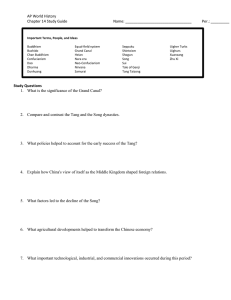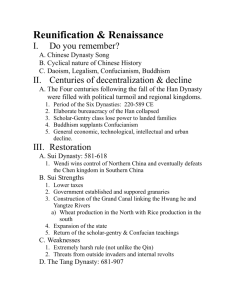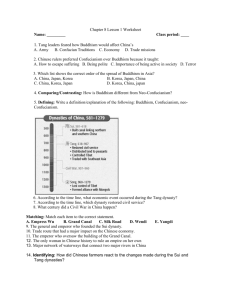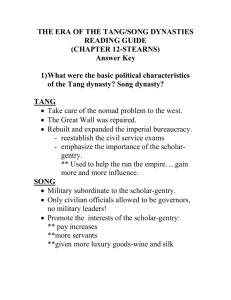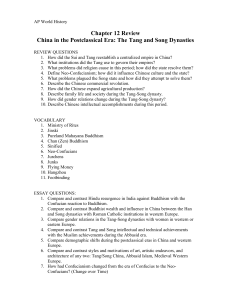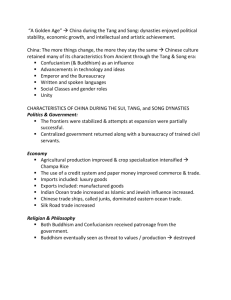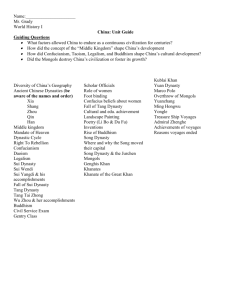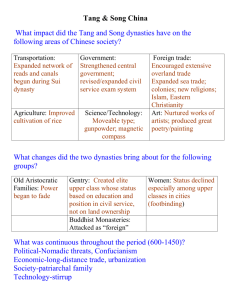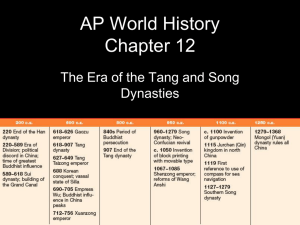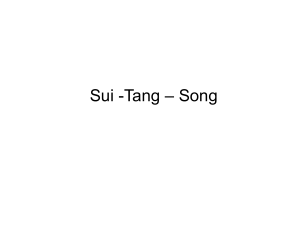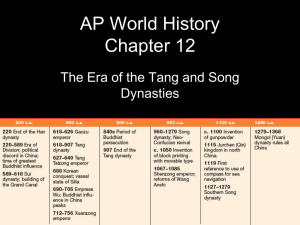Imperial China Sui, Tang, Song Dynasties
advertisement
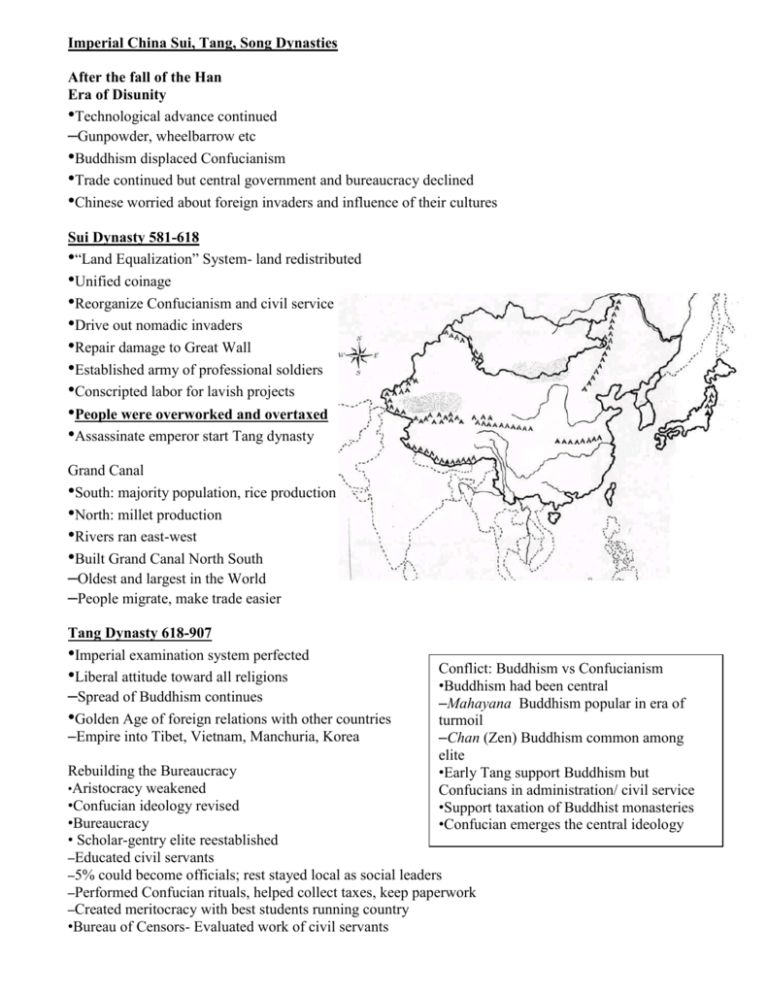
Imperial China Sui, Tang, Song Dynasties After the fall of the Han Era of Disunity •Technological advance continued –Gunpowder, wheelbarrow etc •Buddhism displaced Confucianism •Trade continued but central government and bureaucracy declined •Chinese worried about foreign invaders and influence of their cultures Sui Dynasty 581-618 •“Land Equalization” System- land redistributed •Unified coinage •Reorganize Confucianism and civil service •Drive out nomadic invaders •Repair damage to Great Wall •Established army of professional soldiers •Conscripted labor for lavish projects •People were overworked and overtaxed •Assassinate emperor start Tang dynasty Grand Canal •South: majority population, rice production •North: millet production •Rivers ran east-west •Built Grand Canal North South –Oldest and largest in the World –People migrate, make trade easier Tang Dynasty 618-907 •Imperial examination system perfected •Liberal attitude toward all religions –Spread of Buddhism continues •Golden Age of foreign relations with other countries –Empire into Tibet, Vietnam, Manchuria, Korea Conflict: Buddhism vs Confucianism •Buddhism had been central –Mahayana Buddhism popular in era of turmoil –Chan (Zen) Buddhism common among elite •Early Tang support Buddhism but Confucians in administration/ civil service •Support taxation of Buddhist monasteries •Confucian emerges the central ideology Rebuilding the Bureaucracy •Aristocracy weakened •Confucian ideology revised •Bureaucracy • Scholar-gentry elite reestablished –Educated civil servants –5% could become officials; rest stayed local as social leaders –Performed Confucian rituals, helped collect taxes, keep paperwork –Created meritocracy with best students running country •Bureau of Censors- Evaluated work of civil servants The Growing Importance of the Examination System • Ministry of Rites –Gave regular exams for students from gov’t schools or known teachers –Granted higher status if successful; best got official jobs •Birth, connections important for office Family and Society in the Early Tang-Song Era •Great continuity Culture and trade flourish •Marriage brokers •New technologies •Elite women have broader opportunities •More cosmopolitan culture –Empresses Wu, Wei and Yang Guifei –Cities growing •Divorce widely available •Reestablish safety and importance of Silk Rd •Imported tea, wood and spices •Exported manufactured goods Expanding Agrarian Production and Life in the Country •New areas cultivated •Canals help transport produce • Influence over neighbors •Economy stimulated by advances in farming, finance Foot Foot binding • Aristocratic estates Under influence of Buddhism women enjoy –Divided among peasants relatively higher status, as return of Confucianism, –Scholar-gentry replace aristocracy that ends th Began in Tang but not common until Song Tang Decline by 8 Century Prince Li Yu his concubine, was a suburb dancer. •High taxation “Precious Thing” toe danced inside a six-foot high •Peasant rebellions led to more independent platform shaped like a lotus flower made of gold. local rule ~907 early variation of ballet, though rather than •For 50 years, regional war lords ruled squeezing the feet into toe shoes, Chinese women resorted to permanent disfigurement •By 960 Song Dynasty centralized Broke toes by age 3 but not able to unify Mother bound their daughter’s feet –Khitan independence encourages others For upper-class girls it became a new custom Why upper-class? Song Dynasty 960 - 1279 •Kirhgiz people overthrew Tang form Song •Not able to unite as much as Tang did –Liao (Manchuria/Khitan) and Xi Xia empire to the north •Strengthen Confucianism and civil service –Increased emphasis learning b/c printing •Established gov’t monopoly on tea trade •Become sea power •Create middle/merchant class •Deemphasize military and reestablished tribute system –‘Pay off’ nomads with gifts Power Shift- from N to S •Capital at Hangzhou •Commerce soured •Rice cultivation increases •Most powerful navy in the world A New Phase of Commercial Expansion Greater contact with Buddhist, Islamic regions Silk routes reopened Sea trade Developed by late Tang, Song Junks, magnetic compass Look at page 270. Read about ships. How would Commerce expands these boats facilitate trade overseas? Why do you Credit think the Chinese did not dominate Age of Deposit shops exploration? Flying money Urban growth Changan Tang capital 2 mi The Revival of Confucian Thought •Libraries established •Old texts recovered Neo-Confucians •Neo-Confucians reduce role of women –Confinement –Men allowed great freedom; favored in inheritance, divorce –Women not educated What changes took place when shift back to –Foot binding Confucian thought? How are each consistent with •Stress on personal morality our understanding of Confucian thought from the •Importance of philosophy in everyday life classical period? •Hostility to foreign ideas •Gender, class, age distinctions reinforced Song decline •Never that strong to begin with •Never able to unify all parts –Warlords control large parts in the north •Military and economic weakness –Scholar-gentry given control of army; ineffective –Paper money caused inflation •Mongol invasion 1200s How are the Sui, Tang and Song dynasties different? How are they similar?
